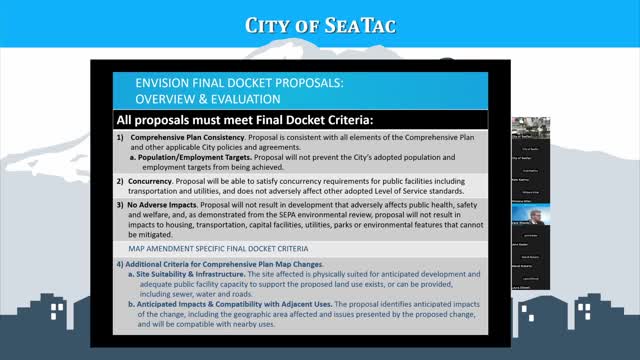City proposes ambitious growth strategy to reshape neighborhoods
October 15, 2024 | SeaTac, King County, Washington
This article was created by AI summarizing key points discussed. AI makes mistakes, so for full details and context, please refer to the video of the full meeting. Please report any errors so we can fix them. Report an error »

In a recent government meeting, officials discussed significant updates to the City of SeaTac's comprehensive plan, which aims to accommodate projected population growth and enhance community infrastructure. The proposals are designed to align with state legislation and local priorities, focusing on sustainable development and improved housing options.
Key criteria for evaluating proposals include consistency with the comprehensive plan, adherence to population and employment targets, and the ability to meet concurrency requirements for public facilities. The updated plan introduces new policies that promote middle housing types and accessory dwelling units (ADUs) in areas previously restricted to single-family homes, reflecting a broader state initiative to diversify housing options.
The comprehensive plan now consists of 11 chapters, with notable changes in the land use element. The city will continue to prioritize growth in urban centers, particularly around light rail stations, while also allowing for new neighborhood villages to support local businesses and housing needs. By 2044, the city aims to add approximately 5,900 housing units and 14,810 jobs, with updated zoning designations to facilitate this growth.
Transportation infrastructure is also a focal point, with plans to enhance multimodal access and connectivity throughout the city. The transportation master plan outlines strategies for improving pedestrian and bicycle facilities, ensuring that neighborhoods are within walking distance of essential services and transit options.
Additionally, the meeting highlighted the importance of addressing historical inequities in housing policies, with new measures aimed at preventing displacement and supporting marginalized communities. The updates to the comprehensive plan and transportation master plan are part of a broader effort to create complete neighborhoods that are resilient, equitable, and sustainable.
As the city moves forward with these proposals, officials emphasized the need for community engagement and collaboration with regional partners to ensure that growth is managed effectively and benefits all residents.
Key criteria for evaluating proposals include consistency with the comprehensive plan, adherence to population and employment targets, and the ability to meet concurrency requirements for public facilities. The updated plan introduces new policies that promote middle housing types and accessory dwelling units (ADUs) in areas previously restricted to single-family homes, reflecting a broader state initiative to diversify housing options.
The comprehensive plan now consists of 11 chapters, with notable changes in the land use element. The city will continue to prioritize growth in urban centers, particularly around light rail stations, while also allowing for new neighborhood villages to support local businesses and housing needs. By 2044, the city aims to add approximately 5,900 housing units and 14,810 jobs, with updated zoning designations to facilitate this growth.
Transportation infrastructure is also a focal point, with plans to enhance multimodal access and connectivity throughout the city. The transportation master plan outlines strategies for improving pedestrian and bicycle facilities, ensuring that neighborhoods are within walking distance of essential services and transit options.
Additionally, the meeting highlighted the importance of addressing historical inequities in housing policies, with new measures aimed at preventing displacement and supporting marginalized communities. The updates to the comprehensive plan and transportation master plan are part of a broader effort to create complete neighborhoods that are resilient, equitable, and sustainable.
As the city moves forward with these proposals, officials emphasized the need for community engagement and collaboration with regional partners to ensure that growth is managed effectively and benefits all residents.
View full meeting
This article is based on a recent meeting—watch the full video and explore the complete transcript for deeper insights into the discussion.
View full meeting
